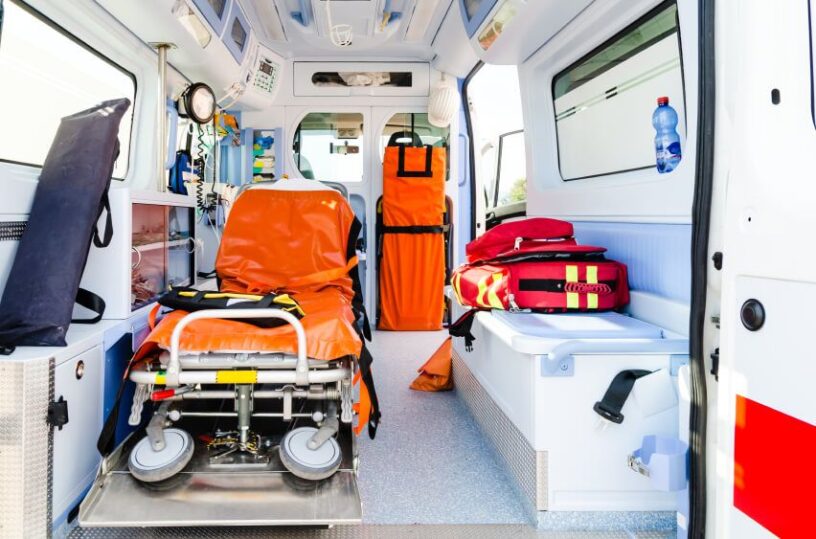Ambulance And Emergency Equipment Market is valued at USD 5815.5 million in 2019. The market size will reach USD 6527.4 million by the end of 2026, growing at a CAGR of 1.6% during the forecast period 2021-2027.
The Ambulance and Emergency Equipment Market involves a wide range of products and devices used in ambulances and emergency response settings. This includes medical equipment, patient transport devices, life-support systems, diagnostic tools, and monitoring devices. These tools play a crucial role in providing pre-hospital care and improving patient outcomes during medical emergencies, accidents, and other critical situations.
Market Size and Growth
- Market Growth: The global ambulance and emergency equipment market is expected to grow at a CAGR of 5% to 7% from 2024 to 2033, driven by the increasing demand for emergency medical services (EMS), rising incidence of accidents, and advancements in healthcare infrastructure.
- Market Size: The market was valued at approximately $6 billion in 2023 and is projected to reach $9 billion to $10 billion by 2033.
Market Segmentation
- By Equipment Type:
- Life-Support and Emergency Resuscitation Devices: Includes defibrillators, ventilators, and oxygen delivery systems.
- Patient Monitoring Systems: Includes heart rate monitors, blood pressure monitors, and pulse oximeters.
- Patient Transport Equipment: Stretchers, wheelchairs, and spine boards.
- Diagnostics and Imaging Tools: Portable ultrasound devices, ECG machines, and other diagnostic tools used in ambulances.
- Infection Control Products: Gloves, masks, sterilizers, and other protective gear.
- First-Aid Kits and Medical Supplies: General first-aid materials like bandages, syringes, and antiseptics.
- By Ambulance Type:
- Emergency Ambulances: Equipped for life-saving interventions during emergencies.
- Transport Ambulances: Used for routine patient transfers.
- Mobile ICUs (Intensive Care Units): Ambulances with advanced life-support capabilities.
- Neonatal Ambulances: Specially equipped to handle neonatal emergencies and transport.
- By End-User:
- Hospitals and Clinics: Primary users of emergency equipment for ambulances and in-hospital use.
- Emergency Medical Services (EMS): Includes private and public ambulance services.
- Fire Departments and Rescue Services: Use of emergency equipment for rescue and disaster response.
- By Geography:
- North America: The largest market due to advanced healthcare systems, higher incidence of accidents, and increasing awareness of emergency care.
- Europe: Second-largest market with robust EMS and healthcare infrastructure.
- Asia-Pacific: Expected to witness rapid growth due to increasing investments in healthcare, rising demand for emergency services, and improving healthcare access.
- Rest of the World: Includes Latin America, Middle East, and Africa, where the market is expanding as healthcare infrastructure develops.
Market Trends
- Technological Advancements in Emergency Equipment:
- Integration of advanced technologies like AI-powered monitoring systems, portable imaging devices, and cloud-connected diagnostic tools is improving the efficiency of emergency medical services.
- Growing Adoption of Electric and Hybrid Ambulances:
- Increasing focus on sustainability and reducing the carbon footprint is driving the adoption of electric and hybrid ambulances, which are being equipped with the latest emergency medical equipment.
- Rising Demand for Advanced Life-Support Systems:
- The growing need for advanced life-support systems, especially in high-income regions, is driving innovation in life-saving equipment such as portable ventilators and defibrillators.
- Expansion of Telemedicine and Remote Monitoring:
- Telemedicine and remote monitoring technologies are being incorporated into ambulances, enabling real-time communication between ambulance crews and hospital emergency departments to improve patient care.
- Increasing Focus on Emergency Preparedness:
- Governments and healthcare organizations are emphasizing the need for emergency preparedness, including better-equipped ambulances and training for emergency responders, which is driving market demand.
Market Drivers
- Rising Number of Road Accidents and Emergencies:
- The increasing incidence of road accidents, heart attacks, and other emergencies is driving the demand for well-equipped ambulances and emergency medical services.
- Growth in Geriatric Population:
- With the global aging population on the rise, there is a growing need for emergency medical services, as older adults are more prone to accidents and medical emergencies.
- Government Investments and Reimbursement Policies:
- Governments across the globe are investing in upgrading EMS infrastructure, and favorable reimbursement policies are encouraging the adoption of advanced emergency medical equipment.
- Advancement in Healthcare Infrastructure:
- The expansion of healthcare infrastructure, especially in developing countries, is creating opportunities for the growth of the ambulance and emergency equipment market.
- Increased Awareness of Emergency Care:
- Awareness campaigns and better education about the importance of immediate emergency care are boosting the demand for high-quality ambulance services and equipment.
Challenges
- High Cost of Advanced Equipment:
- The cost of advanced emergency medical equipment, such as portable diagnostic tools and life-support systems, is often high, making it difficult for smaller EMS providers to adopt.
- Lack of Trained Personnel in Developing Regions:
- In many developing countries, the shortage of trained healthcare professionals and emergency responders limits the effective use of advanced emergency equipment.
- Regulatory Hurdles:
- Compliance with stringent regulations and certification processes for ambulance equipment can slow down market growth.
- Logistical Challenges in Rural Areas:
- Access to emergency medical services and advanced equipment in rural and remote areas is limited, posing a challenge to the broader market.
- Disparity in Healthcare Infrastructure:
- The uneven development of healthcare infrastructure between urban and rural areas is a major challenge, especially in low- and middle-income countries.
Future Outlook
- Adoption of Smart Ambulances:
- The rise of smart ambulances equipped with advanced communication systems, telemedicine capabilities, and AI-based decision support systems is expected to drive future growth.
- Expansion into Emerging Markets:
- The growing healthcare infrastructure in emerging markets, especially in Asia-Pacific, Latin America, and Africa, presents significant opportunities for market expansion.
- Focus on Portable and User-Friendly Devices:
- Manufacturers are focusing on developing more portable, lightweight, and user-friendly emergency devices that can be easily deployed in ambulances and emergency settings.
- Integration of IoT in Emergency Equipment:
- The integration of Internet of Things (IoT) technology in emergency medical equipment for real-time data collection and remote monitoring is likely to become a key trend.
- Increased Focus on Disaster Response and Preparedness:
- With the growing frequency of natural disasters and pandemics, there is an increasing focus on disaster response and preparedness, further driving demand for emergency equipment.
Key Players
- Stryker Corporation: A leading provider of patient transport equipment and emergency medical devices.
- Medtronic: Specializes in advanced life-support systems such as ventilators and defibrillators.
- GE Healthcare: Provides diagnostic and patient monitoring equipment for use in ambulances and emergency departments.
- Philips Healthcare: A key player in patient monitoring systems and portable diagnostic tools for EMS.
- Ambu A/S: Focuses on developing first-aid kits, resuscitation devices, and other emergency care products.
Conclusion
The Ambulance and Emergency Equipment Market is set for steady growth, driven by increasing demand for emergency medical services, advancements in technology, and rising awareness about the importance of immediate emergency care. While challenges such as high costs and disparities in healthcare infrastructure remain, the market is poised for expansion with the integration of advanced technology, increased investment in healthcare systems, and growing adoption of smart ambulance solutions.
Get Free Exclusive PDF Sample Copy of This Research Report https://stringentdatalytics.com/sample-request/ambulance-and-emergency-equipment-market/14688/
Market Segmentations:
Global Ambulance and Emergency Equipment Market: By Company
3M
BLS Systems
Covidine
MCKESSON CORP
Stryker
Allied healthcare products
Drager Medical
Ambu A/S
Emergency Medical International
First Care Products
Emergency Medical Products
Global Ambulance and Emergency Equipment Market: By Type
Transportation Equipment
Burn Care Equipment
Diagnostics and Infection Control Equipment
Blood and Hemorrhage Control Devices
Respiratory, Hypothermia & Cardiac Equipment
Global Ambulance and Emergency Equipment Market: By Application
Ground Ambulance Service
Air Ambulance Service
Water Ambulance Service
Global Ambulance and Emergency Equipment Market: Regional Analysis
The regional analysis of the global Ambulance and Emergency Equipment market provides insights into the market’s performance across different regions of the world. The analysis is based on recent and future trends and includes market forecast for the prediction period. The countries covered in the regional analysis of the Ambulance and Emergency Equipment market report are as follows:
North America: The North America region includes the U.S., Canada, and Mexico. The U.S. is the largest market for Cold-chain Pharma in this region, followed by Canada and Mexico. The market growth in this region is primarily driven by the presence of key market players and the increasing demand for the product.
Europe: The Europe region includes Germany, France, U.K., Russia, Italy, Spain, Turkey, Netherlands, Switzerland, Belgium, and Rest of Europe. Germany is the largest market for Cold-chain Pharma in this region, followed by the U.K. and France. The market growth in this region is driven by the increasing demand for the product in the automotive and aerospace sectors.
Asia-Pacific: The Asia-Pacific region includes Singapore, Malaysia, Australia, Thailand, Indonesia, Philippines, China, Japan, India, South Korea, and Rest of Asia-Pacific. China is the largest market for Cold-chain Pharma in this region, followed by Japan and India. The market growth in this region is driven by the increasing adoption of the product in various end-use industries, such as automotive, aerospace, and construction.
Middle East and Africa: The Middle East and Africa region includes Saudi Arabia, U.A.E, South Africa, Egypt, Israel, and Rest of Middle East and Africa. The market growth in this region is driven by the increasing demand for the product in the aerospace and defense sectors.
South America: The South America region includes Argentina, Brazil, and Rest of South America. Brazil is the largest market for Cold-chain Pharma in this region, followed by Argentina. The market growth in this region is primarily driven by the increasing demand for the product in the automotive sector.
Click Here, To Buy Premium Report https://stringentdatalytics.com/purchase/ambulance-and-emergency-equipment-market/14688/?license=single
Key Points:
- Define, describe and forecast The Global Market by type, application, end user and region.
- Provide enterprise external environment analysis and PEST analysis.
- Provide strategies for company to deal with the impact of COVID-19.
- Provide market dynamic analysis, including market driving factors, market development constraints.
- Provide market entry strategy analysis for new players or players who are ready to enter the market, including market segment definition, client analysis, distribution model, product messaging and positioning, and price strategy analysis.
- Keep up with international market trends and provide analysis of the impact of the COVID-19 epidemic on major regions of the world.
- Analyze the market opportunities of stakeholders and provide market leaders with details of the competitive landscape.
About Stringent Datalytics
Stringent Datalytics offers both custom and syndicated market research reports. Custom market research reports are tailored to a specific client’s needs and requirements. These reports provide unique insights into a particular industry or market segment and can help businesses make informed decisions about their strategies and operations.
Syndicated market research reports, on the other hand, are pre-existing reports that are available for purchase by multiple clients. These reports are often produced on a regular basis, such as annually or quarterly, and cover a broad range of industries and market segments. Syndicated reports provide clients with insights into industry trends, market sizes, and competitive landscapes. By offering both custom and syndicated reports, Stringent Datalytics can provide clients with a range of market research solutions that can be customized to their specific needs.
Contact Us
Stringent Datalytics
Contact No- +1 346 666 6655
Email Id- sales@stringentdatalytics.com




Leave a Reply